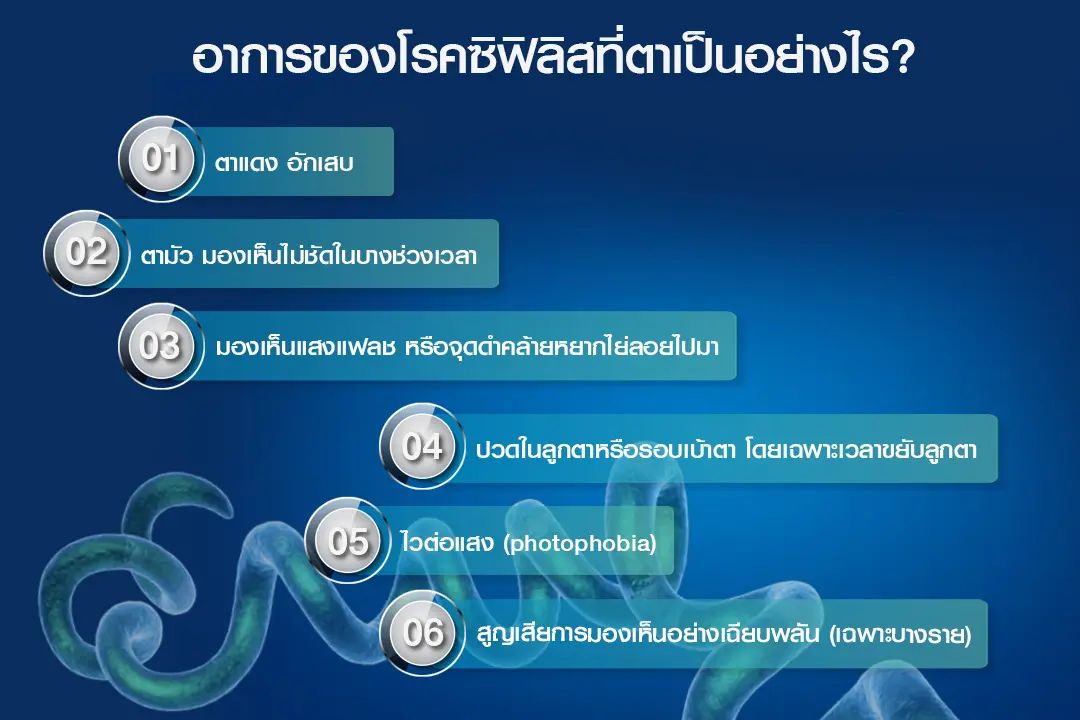Ocular Syphilis: Spot the Signs Early, Save Your Sight!
Eye symptoms like redness, blurred vision, or irritation can stem from various causes—from common conditions like conjunctivitis to more serious infections involving the nervous system. One such overlooked condition is ocular syphilis, a rare but severe complication of a sexually transmitted infection.
In this article, we’ll explore how ocular syphilis differs from other common eye diseases, helping you recognize the signs and seek the right medical care before complications arise.
What is ocular syphilis?
Ocular syphilis is a complication of syphilis, caused by the bacterium Treponema pallidum, that affects the eyes after spreading through the bloodstream and nervous system. It can occur at any stage of the disease but is more commonly observed during the secondary or latent stages.
This condition does not occur exclusively in individuals with weakened immune systems—it can also affect otherwise healthy individuals, especially those engaging in high-risk sexual behaviors such as having multiple sexual partners or unprotected sex.
Ocular syphilis may involve various parts of the eye, including the retina, uvea, optic nerve, or conjunctiva, and can result in vision impairment or permanent blindness if not diagnosed and treated promptly.
Although relatively rare compared to systemic syphilis, ocular involvement is considered an ophthalmic emergency due to its potential for severe and irreversible vision loss.
How dangerous is ocular syphilis?
Ocular syphilis is a serious condition that should never be overlooked, as it can lead to irreversible vision loss if not diagnosed and treated promptly. The Treponema pallidum bacterium can damage critical ocular structures such as the optic nerve and retina—both essential for vision.
What makes ocular syphilis especially dangerous is it often subtle or nonspecific onset. Many individuals may experience mild symptoms or none at all in the early stages, leading to delayed diagnosis and prolonged inflammation that can permanently impair eyesight.
Moreover, ocular involvement may indicate that the infection has already spread to the central nervous system—a condition known as neurosyphilis. This overlap is seen in many cases of ocular syphilis, making it not just an eye problem but also a potential neurological emergency.
For these reasons, ocular syphilis demands immediate evaluation and care by a qualified specialist to prevent long-term complications.
What are the symptoms of ocular syphilis?
Ocular syphilis presents with a wide range of symptoms, depending on which part of the eye is affected by the infection. Common symptoms include:
- Redness and inflammation of the eye
- Blurred or fluctuating vision
- Seeing flashes of light or floaters (black spots moving across vision)
- Eye pain, especially during eye movement
- Sensitivity to light (photophobia)
- Sudden vision loss (in some cases)
These symptoms may develop rapidly or gradually and can occur in one or both eyes. Due to their nonspecific nature, they are often mistaken for other eye conditions such as conjunctivitis, uveitis, or optic neuritis from other causes.
Some patients may not experience significant pain but notice subtle changes in vision, which can delay diagnosis. Without timely intervention, these symptoms may progress to permanent blindness.
Could red eyes or blurred vision be a sign of syphilis?
Red or blurry vision is common and may result from various causes such as allergies, fatigue, or routine infections. However, when these symptoms occur in individuals with risk factors—such as a history of sexually transmitted infections or prior syphilis—they may indicate a more serious issue like ocular syphilis.
Warning signs that these symptoms could be linked to syphilis include:
- No improvement after using standard eye drops
- Blurred vision that worsens at specific times, such as in the morning
- Red eyes without typical allergic signs like itching or discharge
- A known history of syphilis or other STIs
- Accompanying symptoms like eye pain or light sensitivity
If you experience these symptoms and belong to a high-risk group, it’s essential to seek a thorough evaluation from an ophthalmologist or infectious disease specialist. Delay in diagnosis may lead to permanent vision loss.
Who is at risk for ocular syphilis?
While syphilis can affect anyone, certain individuals are at a higher risk of developing ocular complications. The following groups are particularly vulnerable to ocular syphilis:
- Individuals with multiple sexual partners or those who engage in unprotected sex
- People with a past history of syphilis, especially if inadequately treated
- Individuals with HIV or compromised immune systems
- Men who have sex with men (MSM), a group with higher syphilis prevalence
- Intravenous drug users
- Patients previously diagnosed with neurosyphilis (syphilis involving the nervous system)
Even in the absence of systemic symptoms, those in high-risk groups should undergo regular screening, as ocular syphilis can present silently and still cause significant harm.
How common is ocular syphilis?
Ocular syphilis is considered a relatively uncommon complication compared to other forms of systemic syphilis. However, in recent years, reported cases have been steadily rising, particularly among high-risk populations such as individuals with HIV and men who have sex with men (MSM).
According to the U.S. Centers for Disease Control and Prevention (CDC), there has been an increase in ocular syphilis cases in recent years, with many patients presenting with blurred vision and severe eye inflammation. Without prompt treatment, these symptoms can progress to irreversible blindness.
While specific data on ocular syphilis prevalence in Thailand is limited, the overall rise in syphilis cases—especially among sexually active adults—suggests that ocular involvement may also be on the rise.
In short, although ocular syphilis remains relatively rare, its frequency is increasing and warrants serious attention, particularly in individuals with known risk factors.
How is ocular syphilis diagnosed?
Diagnosing ocular syphilis requires a combination of clinical history, ophthalmic examination, and laboratory testing to confirm that ocular inflammation or damage is due to Treponema pallidum infection.
- Ophthalmic Examination: An eye specialist uses tools such as a slit-lamp or ophthalmoscope to examine the retina, optic nerve, uvea, and other internal eye structures.
- Blood Tests for Syphilis: These include non-treponemal tests (e.g., RPR or VDRL) and treponemal-specific tests (e.g., TPHA or FTA-ABS) to confirm syphilis infection in the body.
- Lumbar Puncture (in some cases): If there is suspicion of central nervous system involvement (neurosyphilis), which often coexists with ocular syphilis, a spinal fluid test may be required.
- Additional Tests as Needed: Such as fundus photography or visual field testing, depending on symptoms and clinical findings.
Because ocular syphilis can mimic many other eye diseases, an accurate diagnosis requires a comprehensive approach and should be carried out by specialists in ophthalmology and infectious diseases.
How is ocular syphilis treated?
The primary goal of treating ocular syphilis is to eradicate Treponema pallidum and prevent permanent vision loss. The standard treatment involves antibiotic therapy with penicillin, as recommended by the World Health Organization (WHO) and the U.S. Centers for Disease Control and Prevention (CDC).
- Intravenous Penicillin G (Benzylpenicillin): Administered intravenously at 18–24 million units per day, divided every 4 hours, for a minimum of 10–14 days.
- Penicillin Allergy Cases: For patients allergic to penicillin, desensitization may be required. Alternatively, ceftriaxone may be used under close medical supervision.
- Ophthalmologist Collaboration: Given that ocular syphilis can involve multiple eye structures, ophthalmologic consultation is essential for accurate assessment and follow-up.
- Post-Treatment Monitoring: Follow-up evaluations including visual acuity testing, serologic monitoring, and in some cases repeat lumbar puncture may be necessary to confirm treatment success.
How to care for yourself after treating ocular syphilis
While antibiotic treatment for ocular syphilis is often effective in eliminating the infection, proper post-treatment care is essential to prevent recurrence and support visual recovery.
- Attend All Follow-Up Appointments: This includes repeat eye exams, blood tests to monitor antibody levels, and in some cases, a follow-up lumbar puncture—especially in patients with neurosyphilis.
- Avoid Bright Light and Eye-Straining Activities: Particularly during the first 1–2 weeks after treatment, to reduce the risk of triggering inflammation.
- Maintain Overall Health: Get adequate sleep, eat nutritious meals, and avoid alcohol and recreational drugs to support immune recovery.
- Refrain from Risky Sexual Behaviors Temporarily: Avoid unprotected sex or multiple partners for at least 3 months post-treatment, and get retested before resuming sexual activity.
Can ocular syphilis be prevented?
- Use condoms consistently during all sexual activity: Especially with partners whose STI status is unknown.
- Get routine sexual health checkups: Every 6–12 months, particularly for individuals with high-risk behaviors.
- Avoid having multiple sexual partners at the same time: Or, at the very least, ensure mutual testing and open communication before becoming sexually active.
- If you’ve had syphilis before, follow up with your doctor: To confirm the infection has cleared and to detect any possible reinfection early.
- Pay attention to changes in your vision or eye discomfort: Symptoms like blurry vision, redness, or light sensitivity warrant immediate medical attention.
- Avoid touching your eyes without washing your hands: Especially after sexual activity, to prevent potential transfer of fluids that may contain the bacteria.
Common misconceptions about ocular syphilis
- “Only people with HIV can get ocular syphilis.”
Fact: While people with HIV are at higher risk, ocular syphilis can also occur in individuals with normal immune systems. - “Red or blurry eyes have nothing to do with STIs.”
Fact: The eyes can be an early site of syphilitic symptoms, especially in later stages of the disease when the bacteria spreads. - “If I don’t have genital sores, I don’t have syphilis.”
Fact: Syphilis can enter a latent phase with no visible symptoms and may later manifest in areas like the eyes or nervous system. - “Syphilis will go away on its own.”
Fact: Without proper treatment, syphilis remains in the body and can progress to more dangerous forms, including ocular and neurosyphilis.
What symptoms require immediate medical attention?
- Sudden or rapidly worsening blurred vision
- Flashes of light, floating black spots, or dark shadows in your vision
- Severe eye pain or pain behind the eyes, especially when moving your eyes
- Unexplained vision loss in one eye that does not improve with rest
- Extreme light sensitivity or significant discomfort in bright environments
- Eye symptoms combined with a history of syphilis or known risk factors
If you notice any of the above, seek prompt evaluation by an ophthalmologist or a specialist in sexually transmitted infections to prevent complications such as retinal damage, optic nerve involvement, or central nervous system infection.
Where to treat ocular syphilis?
If you’re experiencing unusual eye symptoms—such as redness, blurred vision, or eye pain—combined with a history of risky sexual behavior or previous syphilis infection, it’s essential to choose a medical facility with specialists in infectious diseases.
At Safe Clinic, our team of experienced physicians specializes in syphilis care, especially complex cases involving ocular or neurological complications. We offer precise, safe diagnostic services and personalized care, following global treatment standards set by the CDC and WHO.
Our services:
- Certified syphilis testing with medical-grade diagnostic kits
- Collaborative eye assessments with our ophthalmologist partners
- Penicillin injection therapy administered by trained professionals
- Post-treatment monitoring to track recovery progress
- Long-term counseling to prevent reinfection
Conclusion
Ocular syphilis can mimic a wide range of other eye conditions, which often leads to misdiagnosis or delayed treatment—especially in patients with unrecognized risk factors such as unprotected sex or a history of syphilis.
Understanding how ocular syphilis differs from routine eye conditions is key to making timely decisions about seeking specialist care and protecting long-term vision health
If you want to book appointment or consult more.
You can booking from website or social media this bottom section



